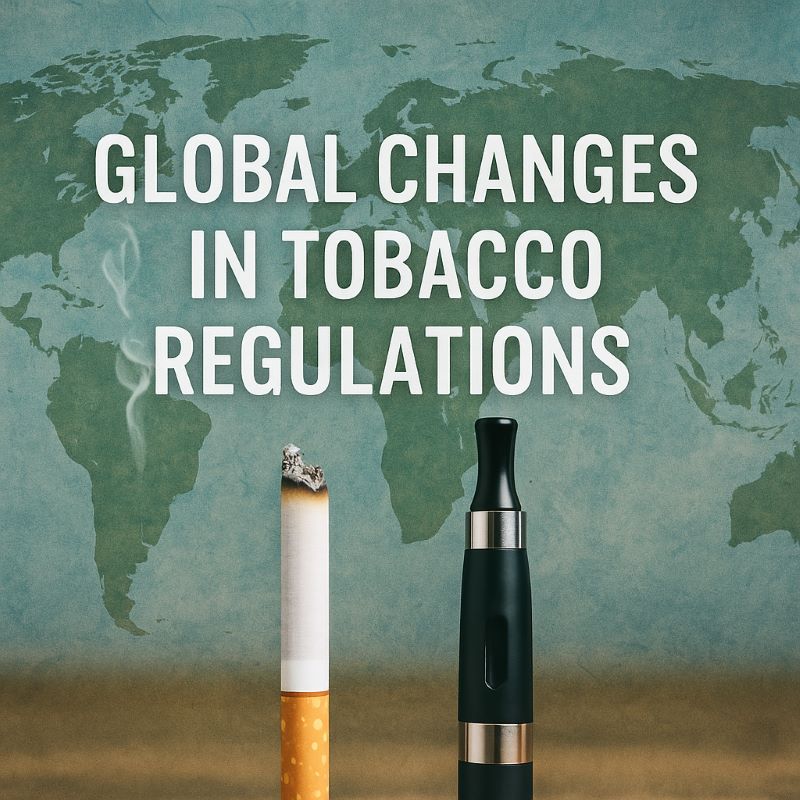Since 2024, global governments have intensified regulatory efforts on both traditional tobacco and novel tobacco products such as e-cigarettes. Driven by public health, economic development, and consumer protection, countries have adopted diverse regulatory approaches, creating both challenges and opportunities for the tobacco industry.
Europe: Stricter Restrictions on Flavors and Disposable E-cigarettes
In 2024, multiple European countries introduced stricter regulations affecting both cigarettes and e-cigarettes. Belgium, France, and Poland have banned the sale of disposable e-cigarettes. Meanwhile, Latvia and Slovenia have restricted e-liquid flavors to only tobacco and mint, aiming to reduce the appeal of these products to minors. Cependant, this also impacts adult consumers who prefer a wider range of flavors.
The UK has also introduced a ban on disposable e-cigarettes, sparking industry debate. E-cigarette companies argue that the policy may push consumers back to traditional cigarettes or exacerbate the circulation of illegal products. Disposable e-cigarettes are particularly popular among young users and serve as a key transition point for smokers moving to novel tobacco products. Their rapidly growing market is now facing significant regulatory pressure.
These regulatory measures reflect the European authorities’ attempt to balance consumer protection and control over tobacco product circulation.
Australia: Looser Prescription-Based Model and the Black Market Dilemma
Australia has implemented a “prescription + pharmacy sales” model for e-cigarettes, with some adjustments in 2023. Starting from October 1, 2024, adults aged 18 and above can purchase e-cigarettes containing 20 mg/mL of nicotine from pharmacies, but they must consult a pharmacist (including product selection and dosage guidance) and provide proof of age. En plus, e-cigarette flavors are limited to mint, mintanol, or tobacco, and packaging must be plain to reduce attractiveness.
Although the policy aims to prevent minors from accessing e-cigarettes, the black market remains a serious issue. According to statistics, approximately AUD 1.9 billion (about 9.2 billion RMB) in illegal tobacco products circulates annually in Australia, leading to tax losses and harming the legitimate market. Some industry insiders believe that strict regulations may instead intensify supply-demand imbalances and highlight the conflict between regulatory measures and market realities.
North America: Flavor Controls and Marketing Restrictions Spark Industry Disruption
Canada has restricted e-cigarette flavors to only tobacco, mint, and menthol, reducing the appeal of these products to young people while also affecting adult consumers who value flavor diversity. The U.S. Food and Drug Administration (FDA) proposed a ban on menthol cigarettes, which has sparked intense debate within the industry. As menthol cigarettes account for about one-third of the U.S. cigarette market, the ban could have profound impacts on manufacturers, retailers, and state governments that rely on tobacco taxes. Industry concerns include the potential for black market smuggling, counterfeit products, and challenges in enforcing regulations. En plus, the ban may conflict with the rights of adult smokers and create tensions between retailers and regulators.
Asia: Divergent Regulatory Approaches Influenced by Economic Considerations
In Asia, the tobacco industry’s economic contribution significantly influences regulatory decisions. Japan and South Korea have embraced heated tobacco products (HNB), which have contributed to a decline in traditional cigarette consumption. Indonesia, d'autre part, has strengthened regulations due to rising youth smoking rates. The country has raised the legal age for purchasing e-cigarettes to 21, prohibited sales to pregnant women, and banned e-cigarette sales within 200 meters of schools and on unverified online platforms. Traditional cigarettes must be sold in packs of 20, and e-liquid nicotine content is limited. En plus, 50% of e-cigarette packaging must display health warnings, and all tobacco and e-cigarette advertisements are banned from social media and public places.
India has banned all e-cigarettes, but illegal trade remains rampant, exposing the limitations of a “one-size-fits-all” ban. Industry stakeholders have called for science-based regulation and taxation instead of outright prohibitions. The Philippines introduced new regulations in June 2024 requiring all e-cigarettes and HNB products to be certified and labeled with standard markings. Companies have a six-month grace period, with full enforcement set to begin on January 1, 2025.
Industry Responses and the Future of Regulatory Balance
Facing global regulatory changes, tobacco companies are adjusting their strategies by diversifying products and focusing on regions with more lenient policies. The effectiveness of regulatory policies ultimately depends on striking a balance between public health goals, economic development needs, and consumer choice. Some stakeholders suggest establishing a cooperative framework between industry and regulators to avoid rigid “one-size-fits-all” bans and adopt more flexible approaches that meet the needs of all parties.
Looking ahead, global tobacco regulations are likely to continue evolving in a contentious yet resilient manner, seeking more sustainable governance models.

